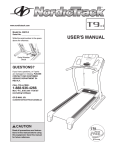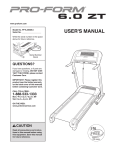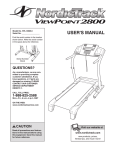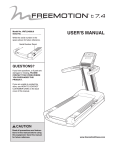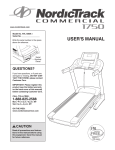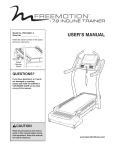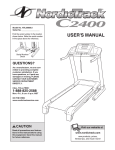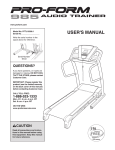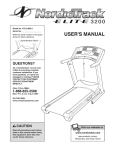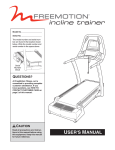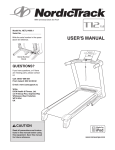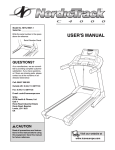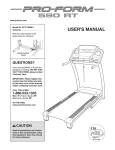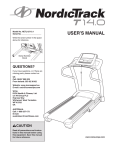Download USER`S MANUAL - Green Fit Co.
Transcript
www.freemotionfitness.com Model No. SFTL25808.0 Serial No. Write the serial number in the space above for reference. Serial Number Decal QUESTIONS? If you have questions, or if parts are damaged or missing, CONTACT THE STORE WHERE YOU PURCHASED THIS PRODUCT. If you are unable to contact the store, see HOW TO CONTACT CUSTOMER CARE on the back cover of this manual. CAUTION Read all precautions and instructions in this manual before using this equipment. Save this manual for future reference. USER'S MANUAL TABLE OF CONTENTS WARNING DECAL PLACEMENT . . . . . . . . . . . . . . . . . . . . . . . . . . . . . . . . . . . . . . . . . . . . . . . . . . . . . . . . . . . . . .2 IMPORTANT PRECAUTIONS . . . . . . . . . . . . . . . . . . . . . . . . . . . . . . . . . . . . . . . . . . . . . . . . . . . . . . . . . . . . . . . . .3 BEFORE YOU BEGIN . . . . . . . . . . . . . . . . . . . . . . . . . . . . . . . . . . . . . . . . . . . . . . . . . . . . . . . . . . . . . . . . . . . . . . .5 ASSEMBLY . . . . . . . . . . . . . . . . . . . . . . . . . . . . . . . . . . . . . . . . . . . . . . . . . . . . . . . . . . . . . . . . . . . . . . . . . . . . . . .6 HOW TO USE THE CHEST PULSE SENSOR . . . . . . . . . . . . . . . . . . . . . . . . . . . . . . . . . . . . . . . . . . . . . . . . . . .12 OPERATION AND ADJUSTMENT . . . . . . . . . . . . . . . . . . . . . . . . . . . . . . . . . . . . . . . . . . . . . . . . . . . . . . . . . . . .13 HOW TO MOVE THE TREADMILL . . . . . . . . . . . . . . . . . . . . . . . . . . . . . . . . . . . . . . . . . . . . . . . . . . . . . . . . . . . .25 TROUBLESHOOTING . . . . . . . . . . . . . . . . . . . . . . . . . . . . . . . . . . . . . . . . . . . . . . . . . . . . . . . . . . . . . . . . . . . . . .26 EXERCISE GUIDELINES . . . . . . . . . . . . . . . . . . . . . . . . . . . . . . . . . . . . . . . . . . . . . . . . . . . . . . . . . . . . . . . . . . .28 PART LIST . . . . . . . . . . . . . . . . . . . . . . . . . . . . . . . . . . . . . . . . . . . . . . . . . . . . . . . . . . . . . . . . . . . . . . . . . . . . . . .30 EXPLODED DRAWING . . . . . . . . . . . . . . . . . . . . . . . . . . . . . . . . . . . . . . . . . . . . . . . . . . . . . . . . . . . . . . . . . . . . . .32 HOW TO CONTACT CUSTOMER CARE . . . . . . . . . . . . . . . . . . . . . . . . . . . . . . . . . . . . . . . . . . . . . . .Back Cover LIMITED WARRANTY . . . . . . . . . . . . . . . . . . . . . . . . . . . . . . . . . . . . . . . . . . . . . . . . . . . . . . . . . . . . . .Back Cover WARNING DECAL PLACEMENT These drawings show the locations of the warning decals. If a decal is missing or illegible, see the back cover of this manual and request a free replacement decal. Apply the decal in the location shown. Note: The decals may not be shown at actual size. ! ! FREEMOTION is a registered trademark of ICON IP, Inc. 2 IMPORTANT PRECAUTIONS WARNING: To reduce the risk of serious injury, read all important precautions and instructions in this manual and all warnings on your treadmill before using your treadmill. FREEMOTION FITNESS assumes no responsibility for personal injury or property damage sustained by or through the use of this product. 1. Before beginning this or any exercise program, consult your physician. This is especially important for persons over age 35 or persons with pre-existing health problems. 11. When connecting the power cord (see page 13), plug the power cord into a surge suppressor (not included) and plug the surge suppressor into a grounded circuit capable of carrying 15 or more amps. No other appliance should be on the same circuit. Do not use an extension cord. 2. It is the responsibility of the owner to ensure that all users of this treadmill are adequately informed of all warnings and precautions. 12. Use only a single-outlet surge suppressor that meets all of the specifications described on page 13. To purchase a surge suppressor, see the back cover of this manual and order part number 146148, or see your local electronics store. 3. Use the treadmill only as described. 4. Place the treadmill on a level surface, with at least 8 ft. (2.4 m) of clearance behind it and 2 ft. (0.6 m) on each side. Do not place the treadmill on any surface that blocks air openings. To protect the floor or carpet from damage, place a mat under the treadmill. 13. Failure to use a properly functioning surge suppressor could result in damage to the control system of the treadmill. If the control system is damaged, the walking belt may slow, accelerate, or stop unexpectedly, which may result in a fall and serious injury. 5. Keep the treadmill indoors, away from moisture and dust. Do not put the treadmill in a garage or covered patio, or near water. 6. Do not operate the treadmill where aerosol products are used or where oxygen is being administered. 14. Keep the power cord and the surge suppressor away from heated surfaces. 15. Never move the walking belt while the power is turned off. Do not operate the treadmill if the power cord or plug is damaged, or if the treadmill is not working properly. (See TROUBLESHOOTING on page 26 if the treadmill is not working properly.) 7. Keep children under age 12 and pets away from the treadmill at all times. 8. The treadmill should be used only by persons weighing 350 lbs. (159 kg) or less. 9. Never allow more than one person on the treadmill at a time. 16. Read, understand, and test the emergency stop procedure before using the treadmill (see HOW TO TURN ON THE POWER on page 15). 10. Wear appropriate exercise clothes when using the treadmill. Do not wear loose clothes that could become caught in the treadmill. Athletic support clothes are recommended for both men and women. Always wear athletic shoes. Never use the treadmill with bare feet, wearing only stockings, or in sandals. 17. Never start the treadmill while you are standing on the walking belt. Always hold the handrails while using the treadmill. 3 23. Inspect and properly tighten all parts of the treadmill regularly. 18. The treadmill is capable of high speeds. Adjust the speed in small increments to avoid sudden jumps in speed. 24. Never insert or drop any object into any opening on the treadmill. 19. The pulse sensors are not medical devices. Various factors, including the user's movement, may affect the accuracy of heart rate readings. The pulse sensors are intended only as an exercise aid in determining heart rate trends in general. 25. 20. Never leave the treadmill unattended while it is running. Always remove the key, unplug the power cord, and switch the reset/off circuit breaker to the “off” position when the treadmill is not in use. (See the drawing on page 5 for the location of the reset/off circuit breaker.) DANGER: Always unplug the power cord immediately after use, before cleaning the treadmill, and before performing the maintenance and adjustment procedures described in this manual. Never remove the motor hood unless instructed to do so by an authorized service representative. Servicing other than the procedures in this manual should be performed by an authorized service representative only. 26. The treadmill is intended for in-home use only. Do not use the treadmill in any commercial, rental, or institutional setting. 21. Do not attempt to move the treadmill until it is properly assembled. (See ASSEMBLY on page 6, and HOW TO MOVE THE TREADMILL on page 25.) You must be able to safely lift 45 lbs. (20 kg) to move the treadmill. 27. Over exercising may result in serious injury or death. If you feel faint or if you experience pain while exercising, stop immediately and cool down. 22. Do not change the incline of the treadmill by placing objects under the treadmill. SAVE THESE INSTRUCTIONS 4 BEFORE YOU BEGIN Thank you for selecting the revolutionary FREEMOTION® t5.8c treadmill. The t5.8c treadmill offers an impressive selection of features designed to make your workouts at home more enjoyable and effective. manual. To help us assist you, note the product model number and serial number before contacting us. The model number and the location of the serial number decal are shown on the front cover of this manual. For your benefit, read this manual carefully before using the treadmill. If you have questions after reading this manual, please see the back cover of this Before reading further, please review the drawing below and familiarize yourself with the labeled parts. Pulse Sensor Console Handrail Accessory Tray Key/Clip Reset/Off Circuit Breaker Walking Belt Power Cord Walking Platform Idler Roller Adjustment Bolts 5 ASSEMBLY Assembly requires two persons. Set the treadmill in a cleared area and remove all packing materials. Do not dispose of the packing materials until assembly is completed. Note: The underside of the treadmill walking belt is coated with high-performance lubricant. During shipping, some lubricant may be transferred to the top of the walking belt or the shipping carton. This is normal and does not affect treadmill performance. If there is lubricant on top of the walking belt, simply wipe off the lubricant with a soft cloth and a mild, non-abrasive cleaner. Assembly requires the included hex key and your own Phillips screwdriver . Use the drawings below to identify the assembly hardware. The number in parentheses below each drawing is the key number of the part, from the PART LIST near the end of this manual. The number after the parentheses is the quantity needed for assembly. Note: If a part is not in the hardware kit, check to see if it is preattached to one of the parts to be assembled. To avoid damaging plastic parts, do not use power tools for assembly. Extra hardware may be included. 3/8" Star Washer (2)–6 #8 x 1/2" Machine Screw (4)–2 #6 x 5/8" Machine Screw (128)–2 3/8" x 3 1/4" Patch Bolt (1)–6 6 #8 x 2 1/4" Machine Screw (3)–6 1. Make sure that the Power Cord (70) is unplugged. Be careful not to pinch the Power Cord. 1 ! Plastic Ties ! Slide the Upright Cover (not shown) off the Upright (81). Orient the Upright and the plastic ties as shown. Set the Upright on the tabs on the Frame (53). Attach the Upright to the Frame with four 3/8" x 3 1/4" Patch Bolts (1) and four 3/8" Star Washers (2). Start all four Patch Bolts before tightening any of them. Be careful not to pinch the Upright Wire (111). 81 1 2 1 2 53 111 70 2. Insert the end of the Upright Wire (111) through the looped plastic ties at the top of the Upright (81). Make sure that the Upright Wire is behind the crossbars on the Upright. Then, gently pull up on the Upright Wire as you tighten the plastic ties around the Upright Wire. 2 Plastic Ties 81 Crossbar Crossbar 7 111 Crossbar 3. Slide the Upright Cover (80) down onto the Upright (81). Be careful not to pinch the Upright Wire (111). Be careful not to hit the ceiling. 3 111 81 80 4. Have a second person hold the handrail assembly near the Upright (81). Insert the Upright Wire (111) up through the center of the handrail assembly. Slide the bracket on the handrail assembly over the crossbar on the Upright and set the handrail assembly on the Upright. Be careful not to pinch any wires. 4 Handrail Assembly Bracket 81 111 Crossbar 8 5. Have a second person hold the Console (101) near the handrail assembly. 5 Connect the Upright Wire (111) and the handrail wires to the console wires. Make sure that the console wire and the handrail wire that you are connecting have connectors that are the same size. See the lower drawing. The connectors should slide together easily and snap into place. If they do not, turn one connector and then try again. IF THE CONNECTORS ARE NOT CONNECTED PROPERLY, THE CONSOLE MAY BE DAMAGED WHEN THE POWER IS TURNED ON. 101 Console Wires Handrail Wires Handrail Wire 111 Insert the excess wires down into the Upright Cover (80). Handrail Assembly 80 Set the Console (101) on the handrail assembly. Be careful not to pinch any wires. 111 Console Wire 6. Align the holes in the Console (101) with the holes in the handrail assembly and the holes in the Upright (not shown). Attach the Console and the handrail assembly to the Upright with two 3/8" x 3 1/4" Patch Bolts (1) and two 3/8" Star Washers (2). Do not fully tighten the Patch Bolts yet. Note: It may be helpful to press the indicated bracket against the Upright (81) and to press down on the Console to align the holes. 6 101 1 2 Bracket 81 9 Handrail Assembly 7. Make sure that the teeth on the Fan Grill (102) are on the outside of the Upright Cover (80) and sit inside the grooves on the Upright Cover. 7 Tighten two #6 x 5/8" Machine Screws (128) into the Upright Cover (80) in the locations shown. Be careful not to overtighten the Machine Screws. 128 Teeth 128 102 8. Tighten the two 3/8" x 3 1/4" Patch Bolts (1). 8 1 10 80 9. Remove the packaging from the Handrail Cover (86). Attach the Handrail Cover to the handrail assembly with six #8 x 2 1/4" Machine Screws (3). Start all six Machine Screws but do not tighten them yet. Start the indicated Machine Screws first. 9 86 First 3 3 10. Tighten two #8 x 1/2" Machine Screws (4) into the bottom of the handrail assembly. Be careful not to overtighten the Machine Screws. First Handrail Assembly 10 See step 9. Tighten the six #8 x 2 1/4" Machine Screws (3). Be careful not to overtighten the Machine Screws. Handrail Assembly 11. If necessary, move the treadmill to the desired location (see HOW TO MOVE THE TREADMILL on page 25). 4 4 11 After the treadmill is placed in the location where it will be used, make sure that the Leveling Feet (64) rest firmly on the floor. If the treadmill rocks even slightly, loosen one of the 1/2" Nuts (36), turn the Leveling Foot clockwise or counterclockwise until the rocking motion is eliminated, and then retighten the Nut. 64 36 12. Make sure that all parts are properly tightened before you use the treadmill. If there are sheets of clear plastic on the treadmill decals, remove the plastic. To protect the floor or carpet, place a mat under the treadmill. Note: Extra hardware may be included. Keep the included hex key in a secure place; the hex key is used to adjust the walking belt (see page 27). 11 HOW TO USE THE CHEST PULSE SENSOR HOW TO PUT ON THE CHEST PULSE SENSOR the chest pulse sensor is not dried after each use, it may remain activated longer than necessary, draining the battery prematurely. The chest pulse sensor consists of two components— the chest strap and the sensor unit. Tabs Sensor Unit • Store the chest pulse sensor in a warm, dry place. Do not store the chest pulse sensor in a plastic bag or other container that may trap moisture. Chest Strap • Do not expose the chest pulse sensor to direct sunlight for extended periods of time; do not expose it to temperatures above 122° F (50° C) or below 14° F (-10° C). Tab Sensor Unit • Do not excessively bend or stretch the sensor unit when using or storing the chest pulse sensor. Buckle • Clean the sensor unit using a damp cloth—never use alcohol, abrasives, or chemicals. The chest strap may be hand washed and air dried. Insert the tab on one end of the chest strap into the hole in one end of the sensor unit, as shown in the inset drawing above. The tab should be flush with the front of the sensor unit. CHEST PULSE SENSOR TROUBLESHOOTING The instructions on the following pages explain how the chest pulse sensor is used with the console. If the chest pulse sensor does not function properly, try the steps below. Next, wrap the chest pulse sensor around your chest and attach the other end of the chest strap to the sensor unit. Adjust the length of the chest strap, if necessary. The chest pulse sensor should be under your clothes, tight against your skin, and as high under the pectoral muscles or breasts as is comfortable. Make sure that the logo on the sensor unit is facing forward and is right-side-up. • Make sure that you are wearing the chest pulse sensor as described at the left. Note: If the chest pulse sensor does not function when positioned as described, move it slightly lower or higher on your chest. • Use saline solution such as saliva or contact lens solution to wet the two electrode areas on the sensor unit. If heart rate readings do not appear until you begin perspiring, rewet the electrode areas. • As you walk or run on the treadmill, position yourself near the center of the walking belt. For the console to display heart rate readings, the user must be within armʼs length of the console. Pull the sensor unit away from your body a few inches and locate the two electrode areas on the inner side (the electrode areas are covered by shallow ridges). Using saline solution such as saliva or contact lens solution, wet both electrode areas. Return the sensor unit to a position against your chest. • The chest pulse sensor is designed to work with people who have normal heart rhythms. Heart rate reading problems may be caused by medical conditions such as premature ventricular contractions (pvcs), tachycardia bursts, and arrhythmia. CHEST PULSE SENSOR CARE AND MAINTENANCE • Thoroughly dry the chest pulse sensor after each use. The chest pulse sensor is activated when the electrode areas are wetted and the chest pusle sensor is put on; the chest pulse sensor shuts off when it is removed and the electrode areas are dried. If • The operation of the chest pulse sensor can be affected by magnetic interference caused by high power lines or other sources. If it is suspected that this is a problem, try relocating the treadmill. 12 OPERATION AND ADJUSTMENT THE PRE-LUBRICATED WALKING BELT Your treadmill features a walking belt coated with highperformance lubricant. IMPORTANT: Never apply silicone spray or other substances to the walking belt or the walking platform. Such substances will deteriorate the walking belt and cause excessive wear. HOW TO PLUG IN THE POWER CORD DANGER: Improper connection of the equipment-grounding conductor can result in an increased risk of electric shock. Check with a qualified electrician or serviceman if you are in doubt as to whether the product is properly grounded. Do not modify the plug provided with the product—if it will not fit the outlet, have a proper outlet installed by a qualified electrician. an equipment-grounding conductor and a grounding plug. Plug the power cord into a surge suppressor, and plug the surge suppressor into an appropriate outlet that is properly installed and grounded in accordance with all local codes and ordinances. IMPORTANT: The treadmill is not compatible with GFCI-equipped outlets. This product is for use on a nominal 120-volt circuit, and has a grounding plug that looks like the plug illustrated in drawing 1 below. A temporary adapter that looks like the adapter illustrated in drawing 2 may be used to connect the surge suppressor to a 2-pole receptacle as shown in drawing 2 if a properly grounded outlet is not available. 1 This product must be grounded. If it should malfunction or break down, grounding provides a path of least resistance for electric current to reduce the risk of electric shock. This product is equipped with a cord having Surge Suppressor Grounding Pin Your treadmill, like any other type of sophisticated electronic equipment, can be seriously damaged by sudden voltage changes in your homeʼs power. Voltage surges, spikes, and noise interference can result from weather conditions or from other appliances being turned on or off. To decrease the possibility of your treadmill being damaged, always use a surge suppressor with your treadmill (see drawing 1 at the right). To purchase a surge suppressor, see the back cover of this manual and order part number 146148, or see your local electronics store. Use only a single-outlet surge suppressor that is UL 1449 listed as a transient voltage surge suppressor (TVSS). The surge suppressor must have a UL suppressed voltage rating of 400 volts or less and a minimum surge dissipation of 450 joules. The surge suppressor must be electrically rated for 120 volts AC and 15 amps. There must be a monitoring light on the surge suppressor to indicate whether it is functioning properly. Failure to use a properly functioning surge suppressor could result in damage to the control system of the treadmill. If the control system is damaged, the walking belt may slow, accelerate, or stop unexpectedly, which may result in a fall and serious injury. Grounded Outlet Box Grounding Pin 2 Grounded Outlet Grounding Plug Grounded Outlet Box Adapter Surge Suppressor Lug Metal Screw The temporary adapter should be used only until a properly grounded outlet (drawing 1) can be installed by a qualified electrician. The green-colored rigid ear, lug, or the like extending from the adapter must be connected to a permanent ground such as a properly grounded outlet box cover. Whenever the adapter is used it must be held in place by a metal screw. Some 2-pole receptacle outlet box covers are not grounded. Contact a qualified electrician to determine if the outlet box cover is grounded before using an adapter. 13 CONSOLE DIAGRAM FEATURES OF THE CONSOLE The treadmill console offers an impressive array of features designed to make your workouts more effective and enjoyable. When you use the manual mode of the console, you can change the speed and incline of the treadmill with the touch of a button. As you exercise, the console will display continuous exercise feedback. You can even measure your heart rate using the handgrip pulse sensor or the chest pulse sensor (see page 12 for information on the chest pulse sensor). In addition, the console features fourteen personal trainer workouts. Each preset workout automatically controls the speed and incline of the treadmill as it guides you through an effective exercise session. The console also offers twelve interactive trainer workouts that allow you to customize your workout. The interactive trainer workouts include three heart rate workouts that control the speed and incline of the treadmill to keep your heart rate near the target heart rate settings. In addition, three fitness test workouts measure your fitness level or your VO2 max. The console also features the new iFit interactive workout system. The iFit system is compatible with iFit interactive workout cards containing workout programs designed to help you achieve specific fitness goals. For example, lose unwanted pounds with the iFit Weight Loss program, or train for a long-distance run with the iFit Marathon program. iFit programs automatically control the speed and incline of the treadmill. To purchase iFit cards, please see the back cover of this manual or go to www.iFit.com. iFit cards are also available at select stores. Whether you select the manual mode or a preset workout, you can listen to your favorite workout music or audio books with the consoleʼs stereo sound system. To turn on the power, see page 15. To use the manual mode, see page 15. To use a personal trainer workout, see page 17. To use a walk/run workout or a manual control workout, see page 19. To use a fitness test workout, see page 20. To use a heart rate workout, see page 21. To use a custom workout, see page 22. To use an iFit workout, see page 23. To use the maintenance mode, see page 24. To use the stereo sound system, see page 24. 14 HOW TO TURN ON THE POWER HOW TO USE THE MANUAL MODE IMPORTANT: If the treadmill has been exposed to cold temperatures, allow it to warm to room temperature before turning on the power. If you do not do this, you may damage the console displays or other electrical components. 1. Insert the key into the console. See HOW TO TURN ON THE POWER at the left. The incline will automatically rise the maximum incline level and then return to the minimum incline level. Plug in the power cord (see page 13). Next, Reset locate the reset/off cirPosition cuit breaker on the treadmill frame near the power cord. Make sure that the circuit breaker is in the “reset” position. 2. Select the manual mode. Each time the key is inserted, the manual mode will be selected. If you have selected a workout, press any of the workout buttons repeatedly until zeros appear in the display. Next, stand on the foot rails of the treadmill. Locate the clip attached to the key (see the drawing at the Key right), and slide the clip Clip securely onto the waistband of your clothes. Then, insert the key into the console. After a moment, the displays will light. IMPORTANT: In an emergency situation, the key can be pulled from the console, causing the walking belt to slow to a stop. Test the clip by carefully taking a few steps backward; if the key is not pulled from the console, adjust the position of the clip. 3. Start the walking belt and adjust the speed. To start the walking belt, press the Start/Stop button, the Speed increase button, or one of the Precision Quick Touch Speed buttons numbered 1 to 12. If you press the Start/Stop button or the Speed increase button, the walking belt will begin to move at 1 mph. As you exercise, change the speed of the walking belt as desired by pressing the Speed increase and decrease buttons. Each time you press a button, the speed setting will change by 0.1 mph; if you hold down the button, the speed setting will change in increments of 0.5 mph. IMPORTANT: If there is a sheet of clear plastic on the face of the console, remove the plastic. To prevent damage to the walking platform, wear clean athletic shoes while using the treadmill. The first time the treadmill is used, observe the alignment of the walking belt, and center the walking belt if necessary (see page 27). If you press one of the numbered Precision Quick Touch Speed buttons, the walking belt will gradually change speed until it reaches the selected speed setting. To select a speed setting that includes a decimal—such as 3.5 mph—press two numbered buttons in succession. For example, to select a speed setting of 3.5 mph, press the 3 button and then immediately press the 5 button. Note: The console will display speed and distance in either miles or kilometers. For simplicity, all instructions in this section refer to miles. To stop the walking belt, press the Start/Stop button. To restart the walking belt, press the Start/Stop button, the Speed increase button, or one of the numbered Precision Quick Touch Speed buttons. 15 4. Change the incline of the treadmill as desired. Regardless of which display mode you select, the speed or incline setting will appear in the display for a few seconds each time you change the setting. To change the incline of the treadmill, press the Incline increase and decrease buttons or one of the Quick Touch Incline buttons numbered 0 to 15. The lower right and lower left displays will show the speed of the walking belt and incline of the treadmill. Each time you press the Incline increase or decrease button, the incline will change by 0.5%. If you press one of the numbered Quick Touch Incline buttons, the incline will gradually change until it reaches the selected incline setting. As you switch between workouts and the manual mode, the console will keep track of the total distance that you have walked or run and the approximate number of calories you have burned. You can keep your totals even when you switch to a new workout. To reset the console, press the Clear button. 5. Select a display mode and monitor your progress with the display. When the manual mode is selected, the console offers six display modes. The display mode that you select will determine which workout information is shown. Press the Display button repeatedly to select the desired display mode. 6. Measure your heart rate if desired. Note: If you use the handgrip pulse sensor and the chest pulse sensor at the same time, the console will not display your heart rate accurately. See page 12 for information on the chest pulse sensor. As you walk or run on the treadmill, the upper display can show the following workout information: Before using the handgrip pulse sensor, remove the sheets of clear plastic from the metal contacts. In addition, make sure that your hands are clean. • The elapsed time. • The distance that you have walked or run. • The speed of the walking belt. • The incline level of the treadmill. • The approximate number of calories you have burned. Contacts To measure your heart rate, stand on the foot rails and hold the contacts for approximately ten seconds—avoid moving your hands. When your pulse is detected, a heart-shaped indicator will flash in the display and your heart rate will be shown. For the most accurate heart rate reading, continue to hold the contacts for about 15 seconds. • The approximate number of calories burned per hour. • Your exercise intensity in METs. One MET is the amount of energy you use while resting. • Your walking or running pace, in minutes per mile or minutes per kilometer. 16 7. Turn on the fan if desired. The fan has high and low speed settings. Press the Fan button repeatedly to select a fan speed or to turn off the fan. Note: If the fan is on when the walking belt stops, the fan will automatically turn off after a few minutes. 8. When you are finished exercising, remove the key from the console. HOW TO USE A PERSONAL TRAINER WORKOUT 1. Insert the key into the console. See step 1 on page 15. 2. Select one of the personal trainer workouts. To select a personal trainer workout, press the Interval Workouts button, the Terrain Workouts button, or the Random Workouts button repeatedly until the name of the desired workout appears in the display. Interval workouts use speed settings to provide a personalized workout. Terrain workouts use speed and incline settings to simulate an actual walking experience. Random workouts use preset speed and incline settings. Step onto the foot rails, press the Start/Stop button, remove the key from the console, and put it in a secure place. The incline will automatically rise the maximum incline level and then return to the minimum incline level. When you are finished using the treadmill, switch the reset/off circuit breaker to the “off” position and unplug the power cord. IMPORTANT: If you do not do this, the treadmillʼs electrical components may wear prematurely. When a workout is selected, the display will show the name, the maximum incline setting, the maximum speed setting and the duration of the workout. The display will also show a profile of the speed settings of the workout. Press the Enter button to select the desired workout. Select your age, your weight, and the workout duration using the increase and decrease buttons next to the Enter button. Press the Enter button after each selection. Note: To use the Interval workouts, you must also enter your minimum and maximum speed settings using the Precision Quick Touch Speed buttons or the Speed increase and decrease buttons. 17 3. Press the Start/Stop button to start the workout. matically adjust to the speed and incline settings for the next segment. Note: If you use an Interval workout, the incline will not adjust automatically. A moment after you press the Start/Stop button, the treadmill will automatically adjust to the first speed and incline settings of the workout. Hold the handrails and begin walking. To stop or restart the workout at any time, press the Start/Stop button. Each workout is divided into segments. One speed setting and one incline setting are programmed for each segment. Note: The same speed and/or incline setting may be programmed for consecutive segments. 4. Select a display mode and monitor your progress with the display. The console offers three display modes. The display mode that you select will determine which workout information is shown. Press the Display button repeatedly to select the desired display mode. During the workout, Current Segment the profile will show your progress. The flashing segment of the profile represents the current segment of the workout. The height of the flashing segment indicates the speed setting for the current segment. At the end of each segment, a series of tones will sound and the next segment of the profile will begin to flash. If a new speed or incline setting is programmed for the next segment of the workout, the speed or incline setting will appear at the top of the display for a few moments to alert you. The display can show the speed of the walking belt, the incline of the treadmill, a profile of the speed settings of the workout, the time remaining in the workout, the distance you have walked or run, the approximate number of calories you have burned, your exercise intensity in METs, the approximate number of calories burned per hour, your pace, and your power output in watts. 5. Measure your heart rate if desired. The workout will continue in this way until the last segment of the profile flashes in the display and the last segment ends. The walking belt will then slow to a stop. See step 6 on page 16. 6. Turn on the fan if desired. See step 7 on page 17. If the speed or incline setting is too high or too low at any time during the workout, you can manually override the setting by pressing the Speed or Incline buttons; however, when the next segment of the workout begins, the treadmill will auto- 7. When you are finished exercising, remove the key from the console. See step 8 on page 17. 18 HOW TO USE A WALK/RUN WORKOUT OR A MANUAL CONTROL WORKOUT 3. Press the Start/Stop button to start the workout. A moment after you press the Start/Stop button, the treadmill will begin moving. Hold the handrails and begin walking. 1. Insert the key into the console. See step 1 on page 15. During the workout, the profile will show the speed of the walking belt. As you exercise, change the speed and incline of the walking belt as desired by pressing the Speed and Incline buttons. 2. Select one of the workouts. To select a walk/run workout, press the Walk/Run Workouts button repeatedly until the 5K Walk, the 10K Run, or the Cross Country workout appears in the display. The workout will continue until you reach your time, distance, or calorie goal. The walking belt will then slow to a stop. To select a manual control workout, press the Manual Control button repeatedly until the Manual Time, the Manual Distance, or the Manual Calories workout appears in the display. The display will show the name, and the time, distance, or calorie goal of the workout. To stop or restart the workout at any time, press the Start/Stop button. 4. Select a display mode and monitor your progress with the display. See step 4 on page 18. 5. Measure your heart rate if desired. Press the Enter button to select the desired workout. Select your age and then your weight using the increase and decrease buttons next to the Enter button. Press the Enter button after each selection. Note: To use the cross country workouts, you must also enter your distance goal. To use a manual control workout, enter your time, distance, or calorie goal. See step 6 on page 16. 6. Turn on the fan if desired. See step 7 on page 17. 7. When you are finished exercising, remove the key from the console. See step 8 on page 17. 19 HOW TO USE A FITNESS TEST WORKOUT speed and incline settings of the fitness test. Begin walking on the treadmill. Note: For the most accurate results, do not hold the handrails during a fitness test workout. The fitness test workouts measure your relative fitness level. For the most accurate results, use a fitness test workout when you are not feeling tired, when you have not eaten for at least two hours, and when you have not exercised for at least 24 hours. During the workout, the speed and incline of the treadmill will periodically change. The speed setting or the incline setting will appear in the display to alert you before each change. IMPORTANT: The Speed and Incline buttons will not function during a fitness test workout. The treadmill features three fitness workouts. The Ebbeling Fitness Test measures VO2 max, or aerobic capacity, and lasts 9 minutes. The Gerkin Fitness Test also measures VO2 max. The Gerkin Fitness Test begins with a three-minute warm-up period and ends after either 14 minutes or when you reach a certain heart rate. The FreeMotion Fitness Test measures your fitness level on a scale of 1 to 10. The FreeMotion Fitness Test ends after either 28 minutes or when you reach a certain heart rate. Note: If you press the Start/Stop button during the fitness test, the fitness test will end. When the workout ends, the walking belt will slow to a stop and your fitness level or VO2 max will appear in the display. 1. Put on the chest pulse sensor. If your pulse is not detected during the workout, the words CHECK HEART RATE MONITOR will appear in the display and the speed of the treadmill may automatically decrease. If your pulse is still not detected, the fitness test will be aborted. To use a fitness test, you must wear the chest pulse sensor or use the handgrip pulse sensor. Note: For best results, you should wear the chest pulse sensor. 5. Select a display mode and monitor your progress with the display. 2. Insert the key into the console. See step 1 on page 15. See step 4 on page 18. Note: The fitness tests will display your fitness level instead of your exercise intensity in METs. The console may display a “W” when you are warming up or a “C” when you are cooling down. 3. Select a fitness test workout. To select a fitness test workout, press the Fitness Tests button repeatedly until the name of the desired fitness test appears in the display. 6. Turn on the fan if desired. Press the Enter button to select the desired workout. Select your age and then your weight using the increase and decrease buttons next to the Enter button. Press the Enter button after each selection. Note: To use the Ebbeling Fitness Test, you must also enter your gender. See step 7 on page 17. 7. When you are finished exercising, remove the key from the console. See step 8 on page 17. 4. Press the Start/Stop button to start the workout. A moment after you press the Start/Stop button, the treadmill will automatically adjust to the first 20 HOW TO USE A HEART RATE WORKOUT mill will automatically adjust to the first speed and incline settings of the workout. Hold the handrails and begin walking. CAUTION: If you have heart problems, or if you are over 60 years of age and have been inactive, do not use the pulse workouts. If you are taking medication regularly, consult your physician to find out whether the medication will affect your exercise heart rate. The heart rate workouts are divided into several one-minute segments. One target heart rate setting is programmed for each segment. The same target heart rate setting may be programmed for consecutive segments. For a shorter workout, simply stop the workout before it ends. 1. Put on the chest pulse sensor. During all heart rate workouts, the console will regularly compare your heart rate to the target heart rate setting. If your heart rate is too far below or above the target heart rate setting for the current segment, the speed of the walking belt will automatically increase or decrease to bring your heart rate closer to the target heart rate setting. To use a heart rate workout, you must wear the chest pulse sensor or use the handgrip pulse sensor. Note: For best results, you should wear the chest pulse sensor. 2. Insert the key into the console. If the speed or incline setting is too high or too low at any time during the workout, you can adjust the setting with the Speed or Incline buttons. However, each time the console compares your heart rate to the target heart rate setting, the speed of the treadmill may automatically change to bring your heart rate closer to the target heart rate setting. See step 1 on page 15. 3. Select one of the heart rate workouts. To select a heart rate workout, press the Heart Rate Control button repeatedly until the desired workout appears in the display. Press the Enter button to select the desired workout. To stop or restart the workout at any time, press the Start/Stop button. Select your age and then your weight using the increase and decrease buttons next to the Enter button. Press the Enter button after each selection. Note: To use the constant heart rate and variable heart rate workouts, you must also enter your target maximum heart rate. If the target maximum heart rate setting is changed, the intensity level of the entire workout will change. Note: To calculate your target maximum heart rate see EXERCISE INTENSITY on page 28. 5. Select a display mode and monitor your progress with the display. See step 4 on page 18. 6. Turn on the fan if desired. See step 7 on page 17. 7. When you are finished exercising, remove the key from the console. 4. Press the Start/Stop button to start the workout. See step 8 on page 17. A moment after the Start/Stop button is pressed, the walking belt will begin to move and the tread- 21 HOW TO USE A CUSTOM WORKOUT segment. At the end of each segment, a series of tones will sound and the next segment of the profile will begin to flash. If a new speed or incline setting is programmed for the next segment of the workout, the speed or incline setting will appear at the top of the display for a few moments to alert you. 1. Insert the key into the console. See step 1 on page 15. 2. Select one of the custom workouts. The workout will continue in this way until the last segment of the profile flashes in the display and the last segment ends. The walking belt will then slow to a stop. To select a custom workout, press the Custom Workouts button repeatedly until the desired workout appears in the display. The display will show the name, the maximum incline setting, the maximum speed setting, and the duration of the workout. Note: To create a custom workout, see step 3 on page 24. If the speed or incline setting is too high or too low at any time during the workout, you can manually override the setting by pressing the Speed or Incline buttons; however, when the next segment of the workout begins, the treadmill will automatically adjust to the speed and incline settings for the next segment. Press the Enter button to select the desired workout. Select your age and then your weight using the increase and decrease buttons next to the Enter button. Press the Enter button after each selection. 3. Press the Start/Stop button to start the workout. A moment after you press the Start/Stop button, the treadmill will automatically adjust to the first speed and incline settings that you programmed previously. Hold the handrails and begin walking. Each custom workout is divided into one-minute segments. One speed setting and one incline setting are programmed for each segment. During the workout, the profile will Current Segment show your progress. The flashing segment of the profile represents the current segment of the workout. The height of the flashing segment indicates the incline setting for the current To stop or restart the workout at any time, press the Start/Stop button. The speed of the walking belt will gradually increase to the speed setting of the current segment. 4. Select a display mode and monitor your progress with the display. See step 4 on page 18. 5. Measure your heart rate if desired. See step 6 on page 16. 6. Turn on the fan if desired. See step 7 on page 17. 7. When you are finished exercising, remove the key from the console. See step 8 on page 17. 22 HOW TO USE AN IFIT WORKOUT A personal trainer will guide you through the workout. 1. Insert the key into the console. At the end of each segment, a series of tones will sound. If a new speed or incline setting is programmed for the next segment of the workout, the speed or incline setting will appear at the top of the display for a few moments to alert you. See step 1 on page 15. 2. Insert an iFit card and select a workout. To use an iFit workout, insert an iFit card into the iFit slot on the side of the console; make sure that the iFit card is oriented as shown. If the speed or incline setting for the current segment is too high or too low, you can manually override the setting by pressing the Speed or Incline buttons; however, when the next segment begins, the treadmill will automatically adjust to the speed and incline settings for the next segment. iFit Slot To stop the workout at any time, press the Start/Stop button. To restart the workout, press the Start/Stop button or the Speed increase button. The walking belt will begin to move. When the next segment of the workout begins, the treadmill will automatically adjust to the speed and incline settings for the next segment. iFit Card Next, select an iFit workout by pressing the increase and decrease buttons next to the Enter button. When an iFit workout is selected, the display will show the name of the workout, the workout time, the maximum speed setting, and the maximum incline setting of the workout. 4. Select a display mode and monitor your progress with the display. See step 5 on page 16. 5. Measure your heart rate if desired. Press the Enter button to select the desired workout. Select your age and then your weight using the increase and decrease buttons next to the Enter button. Press the Enter button after each selection. See step 6 on page 16. 6. Turn on the fan if desired. Each iFit workout is divided into one-minute segments. One speed setting and one incline setting are programmed for each segment. Note: The same speed and/or incline setting may be programmed for consecutive segments. See step 7 on page 17. 7. When you are finished exercising, remove the key from the console. See step 8 on page 17. 3. Press the Start/Stop button to start the workout. CAUTION: Always remove iFit cards from the iFit slot when you are not using them. A moment after you press the button, the treadmill will automatically adjust to the first speed and incline settings of the workout. Hold the handrails and begin walking. 23 HOW TO USE THE MAINTENANCE MODE 3. Create a custom workout. The console has a maintenance mode that keeps track of the total number of hours that the treadmill has been operated and the total distance that the walking belt has moved. The maintenance mode also allows you to adjust the maximum workout time, the pause timeout, and the sleep timeout. You can also select the desired language and disable or enable the safety key. If desired, create a custom workout. Press the Display button until the desired custom workout is highlighted. Then press the Enter button. Program a speed setting and an incline setting for the first one-minute segment by pressing the Speed and Incline buttons. Press the Enter button to move to the next segment and continue programming segments for 30 segments. Press the Enter button after you have programmed the last segment. Then press the Display button until you exit the maintenance mode. 1. Select the maintenance mode. To select the maintenance mode, hold down the Clear button and the Enter button for several seconds. To exit the maintenance mode at any time, remove the key from the console. Press the Display button to move between screens. Press the Back button to return to a previous screen. To change the settings, press the increase and decrease buttons next to the Enter button. You can also disable or enable the safety key. When the safety key is enabled, the key must be inserted into the console for the treadmill to turn on. To disable or enable the safety key, remove the key from the console and hold down the Clear button and the Enter button for several seconds. Push the increase or decrease button. To enable the safety key, insert the key into the console. For best results, operate the treadmill with the safety key enabled. 2. Set user preferences. When you select the maintenance mode, the display will show the total number of hours and the total number of miles (or kilometers) that the walking belt has moved. Press the Display button to move to the next screen. HOW TO USE THE STEREO SOUND SYSTEM If desired, set the maximum workout time for the Random, Interval, Terrain, Manual Time, and Heart Rate workouts using the increase and decrease buttons. To play music or audio books through the consoleʼs stereo speakers, you must connect your MP3 player, CD player, or other personal audio player to the console. Locate the audio wire and plug it into the MP3 jack on the side of the console labeled IN. Then, plug the other end into a jack on your MP3 player, CD player, or other personal audio player. Make sure that the audio wire is fully plugged in. Next, press the Display button to move the cursor to the pause timeout. Set the pause timeout, if desired. The pause timeout begins when the walking belt stops. When the pause timeout ends, the display will return to the main screen and your distance and calories count will be reset. Next, press the Play button on your MP3 player, CD player, or other personal audio player. Then, adjust the volume on your personal audio player. To use headphones, plug the headphones into the headphone jack near the audio jack. Press the Display button to move the cursor to the sleep timeout. Set the sleep timeout, if desired. The sleep timeout begins when the display returns to the main screen. When the sleep timeout ends, the incline will lower to the lowest setting and the screen saver will appear. If you are using a personal CD player and the CD skips, set the CD player on the floor or another flat surface instead of on the console. Press the Display button to move to the default volume. Set the default volume, if desired. Next, press the Display button to move to the next screen. You may be able to select one of five languages for the displays. If desired, select a language for the displays. 24 HOW TO MOVE THE TREADMILL Due to the size and weight of the treadmill, moving it requires two or three persons. Before moving the treadmill, plug in the power cord and insert the key into the console (see HOW TO TURN ON THE POWER on page 15). Raise the incline to the highest position. Then, remove the key and unplug the power cord. Hold the handle firmly in the location shown at the right. CAUTION: To decrease the possibility of damage to the treadmill or of injury, do not lift the treadmill by the handrail. Carefully roll the treadmill on the wheels to the desired location and then lower it to the level position. CAUTION: To reduce the risk of injury, use extreme caution while moving the treadmill. Do not attempt to move the treadmill over uneven surfaces. Handle Wheels After the treadmill is placed in the location where it will be used, make sure that the leveling feet rest firmly on the floor. If the treadmill rocks even slightly, loosen one of the nuts, turn the leveling foot clockwise or counterclockwise until the rocking motion is eliminated, and retighten the nut. Nuts Leveling Feet 25 TROUBLESHOOTING Most treadmill problems can be solved by following the steps below. Find the symptom that applies, and follow the steps listed. If further assistance is needed, please see the back cover of this manual. PROBLEM: The power does not turn on SOLUTION: a. Make sure that the power cord is plugged into a surge suppressor, and that the surge suppressor is plugged into a properly grounded outlet (see page 13). Use only a single-outlet surge suppressor that meets all of the specifications described on page 13. IMPORTANT: The treadmill is not compatible with GFCI-equipped outlets. b. After the power cord has been plugged in, make sure that the key is inserted into the console. c. Check the reset/off circuit breaker located on the treadmill frame near the power cord. If the switch protrudes as shown, the circuit breaker has tripped. To reset the circuit breaker, wait for five minutes and then press the switch to the reset position. PROBLEM: The power turns off during use c Tripped Position Reset Position SOLUTION: a. Check the reset/off circuit breaker (see the drawing above). If the circuit breaker has tripped, wait for five minutes and then press the switch to the reset position. b. Make sure that the power cord is plugged in. If the power cord is plugged in, unplug it, wait for five minutes, and then plug it back in. c. Remove the key from the console. Reinsert the key into the console. d. If the treadmill still will not run, please see the back cover of this manual. PROBLEM: The incline of the treadmill does not change correctly SOLUTION: a. The incline system may need to be calibrated. To initiate the calibration routine, switch the reset/off circuit breaker to the off position, wait 5 seconds, and then switch the circuit breaker back to the reset position. During the calibration routine, the treadmill will automatically travel to the highest incline level and then return to the initial level. b. If the incline system still does not function properly, please see the back cover of this manual. 26 PROBLEM: The walking belt slows when walked on SOLUTION: a. Use only a single-outlet surge suppressor that meets all of the specifications described on page 13. b. If the walking belt is overtightened, treadmill performance may decrease and the walking belt may become damaged. Remove the key and UNPLUG THE POWER CORD. Using the hex key, turn both idler roller bolts counterclockwise, 1/4 of a turn. When the walking belt is properly tightened, you should be able to lift each edge of the walking belt 3 to 4 in. (8 to 10 cm) off the walking platform. Be careful to keep the walking belt centered. Then, plug in the power cord, insert the key, and run the treadmill for a few minutes. Repeat until the walking belt is properly tightened. b 3–4 in. Idler Roller Bolts c. If the walking belt still slows when walked on, please see the back cover of this manual. PROBLEM: The walking belt is off-center or slips when walked on SOLUTION: a. If the walking belt is off-center, remove the key and UNPLUG THE POWER CORD. If the walking belt has shifted to the left, use the hex key to turn the left idler roller bolt clockwise 1/2 of a turn; if the walking belt has shifted to the right, turn the left idler roller bolt counterclockwise 1/2 of a turn. Be careful not to overtighten the walking belt. Plug in the power cord, insert the key, and run the treadmill for a few minutes. Repeat until the walking belt is centered. b. If the walking belt slips when walked on, first remove the key and UNPLUG THE POWER CORD. Using the hex key, turn both idler roller bolts clockwise, 1/4 of a turn. When the walking belt is correctly tightened, you should be able to lift each edge of the walking belt 3 to 4 in. (8 to 10 cm) off the walking platform. Be careful to keep the walking belt centered. Then, plug in the power cord, insert the key, and carefully walk on the treadmill for a few minutes. Repeat until the walking belt is properly tightened. 27 a b EXERCISE GUIDELINES WARNING: Before beginning any exercise program, consult your physician. This is especially important for persons over age 35 or persons with pre-existing health problems. The pulse sensor is not a medical device. Various factors may affect the accuracy of heart rate readings. The pulse sensor is intended only as an exercise aid in determining heart rate trends in general. These guidelines will help you to plan your exercise program. For detailed exercise information, obtain a reputable book or consult your physician. Remember, proper nutrition and adequate rest are essential for successful results. EXERCISE INTENSITY Whether your goal is to burn fat or to strengthen your cardiovascular system, exercising at the proper intensity is the key to achieving results. You can use your heart rate as a guide to find the proper intensity level. The chart below shows recommended heart rates for fat burning and aerobic exercise. Burning Fat—To burn fat effectively, you must exercise at a low intensity level for a sustained period of time. During the first few minutes of exercise, your body uses carbohydrate calories for energy. Only after the first few minutes of exercise does your body begin to use stored fat calories for energy. If your goal is to burn fat, adjust the intensity of your exercise until your heart rate is near the lowest number in your training zone. For maximum fat burning, exercise with your heart rate near the middle number in your training zone. Aerobic Exercise—If your goal is to strengthen your cardiovascular system, you must perform aerobic exercise, which is activity that requires large amounts of oxygen for prolonged periods of time. For aerobic exercise, adjust the intensity of your exercise until your heart rate is near the highest number in your training zone. WORKOUT GUIDELINES Warming Up—Start with 5 to 10 minutes of stretching and light exercise. A warm-up increases your body temperature, heart rate, and circulation in preparation for exercise. Training Zone Exercise—Exercise for 20 to 30 minutes with your heart rate in your training zone. (During the first few weeks of your exercise program, do not keep your heart rate in your training zone for longer than 20 minutes.) Breathe regularly and deeply as you exercise–never hold your breath. Cooling Down—Finish with 5 to 10 minutes of stretching. Stretching increases the flexibility of your muscles and helps to prevent post-exercise problems. To find the proper intensity level, find your age at the bottom of the chart (ages are rounded off to the nearest ten years). The three numbers listed above your age define your “training zone.” The lowest number is the heart rate for fat burning, the middle number is the heart rate for maximum fat burning, and the highest number is the heart rate for aerobic exercise. EXERCISE FREQUENCY To maintain or improve your condition, complete three workouts each week, with at least one day of rest between workouts. After a few months of regular exercise, you may complete up to five workouts each week, if desired. Remember, the key to success is to make exercise a regular and enjoyable part of your everyday life. 28 SUGGESTED STRETCHES The correct form for several basic stretches is shown at the right. Move slowly as you stretch—never bounce. 1. Toe Touch Stretch Stand with your knees bent slightly and slowly bend forward from your hips. Allow your back and shoulders to relax as you reach down toward your toes as far as possible. Hold for 15 counts, then relax. Repeat 3 times. Stretches: Hamstrings, back of knees and back. 1 2. Hamstring Stretch Sit with one leg extended. Bring the sole of the opposite foot toward you and rest it against the inner thigh of your extended leg. Reach toward your toes as far as possible. Hold for 15 counts, then relax. Repeat 3 times for each leg. Stretches: Hamstrings, lower back and groin. 2 3. Calf/Achilles Stretch With one leg in front of the other, reach forward and place your hands against a wall. Keep your back leg straight and your back foot flat on the floor. Bend your front leg, lean forward and move your hips toward the wall. Hold for 15 counts, then relax. Repeat 3 times for each leg. To cause further stretching of the achilles tendons, bend your back leg as well. Stretches: Calves, achilles tendons and ankles. 3 4 4. Quadriceps Stretch With one hand against a wall for balance, reach back and grasp one foot with your other hand. Bring your heel as close to your buttocks as possible. Hold for 15 counts, then relax. Repeat 3 times for each leg. Stretches: Quadriceps and hip muscles. 5. Inner Thigh Stretch Sit with the soles of your feet together and your knees outward. Pull your feet toward your groin area as far as possible. Hold for 15 counts, then relax. Repeat 3 times. Stretches: Quadriceps and hip muscles. 29 5 PART LIST—Model No. SFTL25808.0 To locate the parts listed below, see the EXPLODED DRAWING near the end of this manual. Key No. Qty. 1 2 3 4 5 6 7 8 9 10 11 12 13 14 15 16 17 18 19 20 21 22 23 24 25 26 27 28 29 30 31 32 33 34 35 36 37 38 39 40 41 42 43 44 45 46 47 48 49 50 6 6 6 2 12 2 2 6 2 10 1 2 2 1 1 4 23 4 6 2 8 2 13 26 22 8 2 8 2 8 1 2 2 14 2 2 4 2 2 2 6 2 2 1 2 1 1 1 2 1 Description Key No. Qty. 3/8" x 3 1/4" Patch Bolt 3/8" Star Washer #8 x 2 1/4" Machine Screw #8 x 1/2" Machine Screw 3/8" x 1 5/8" Bolt 3/8" x 2 1/2" Bolt 5/16" x 2 1/2" Bolt 5/16" x 1 1/2" Bolt 1/4" x 3/4" Bolt 1/4" x 1" Bolt 1/4" x 2 1/2" Bolt 1/4" x 1/2" Patch Bolt 1/2" x 3 1/2" Bolt 1/2" x 1 5/8" Bolt 1/2" x 2 1/2" Bolt 5/16" x 1/2" Bolt #8 x 1/2" Tek Screw #8 x 2 5/8" Screw #8 x 2" Screw #6 x 1/4" Screw 1/4" x 3/8" Screw #10 x 5/16" Screw #8 x 1/2" Washer Head Screw #8 x 1/2" Screw #8 x 3/4" Screw #3 x 1/4" Screw #8 x 1" Screw #6 x 1/2" Screw 1/4" x 1/2" Bolt #8 Star Washer 1/4" Star Washer 5/16" Flat Washer 5/16" Lock Washer 3/8" Locknut 1/2" Jam Nut 1/2" Nut Cap Clip 5/16" Locknut 1/4" Flat Washer 1/4" Nut Plastic Insert Reed Switch Stand-Off Rear Platform Bracket Cover Walking Platform Belt Guide Walking Belt Rear Platform Bracket Front Platform Bracket Platform Cushion Magnet 51 52 53 54 55 56 57 58 59 60 61 62 63 64 65 66 67 68 69 70 71 72 73 74 75 76 77 78 79 80 81 82 83 84 85 86 87 88 89 90 91 92 93 94 95 96 97 98 99 100 30 1 1 1 1 4 1 1 1 1 2 1 2 1 2 1 1 1 1 1 1 1 1 1 2 1 1 2 1 2 1 1 1 1 1 1 1 1 1 2 1 1 1 1 1 1 15 1 1 1 2 Description R0909A Reed Switch Controller Frame Drive Motor Motor Bushing Motor Mounting Plate Motor Belt Left Rear Cap Insert Rear Cap Cap Insert Bracket Right Rear Cap Insert Rear Platform Bracket Bearing Idler Roller Leveling Foot Grommet Hood Front Cap Electronics Bracket Reset/Off Circuit Breaker Power Cord Power Cord Grommet Left Side Cover Right Side Cover Hood Bracket Roller Cover Incline Motor Front Wheel Lift Frame Lift Frame Spacer Upright Cover Upright Bottom Handrail Cover Handrail Right Handrail Cover Left Handrail Cover Handrail Cover Small Console Pulse Bar Crossbar Front Platform Bracket Cover Left Upper Pulse Plate Left Lower Pulse Plate Left Pulse Plate Base Right Upper Pulse Plate Right Lower Pulse Plate Right Pulse Plate Base Cable Tie Console Bracket Console Back Access Door #6 Flat Washer Key No. Qty. 101 102 103 104 105 106 107 108 109 110 111 112 113 114 115 116 117 118 1 1 1 1 1 2 1 1 1 1 1 1 1 2 2 4 1 1 Description Key No. Qty. 119 120 121 122 123 124 125 126 127 128 129 130 131 * * * * * Console Fan Grill Fan Cover Console Fan Accessory Tray Speaker Key/Clip Audio Wire Chest Pulse Strap Chest Pulse Sensor Upright Wire Hex Key Drive Roller Pulley Walking Platform Pad 1/2" Washer #8 x 2 1/4" Screw Large English Warning Decal Large French Warning Decal 2 1 2 1 1 2 1 1 4 2 6 2 2 – – – – – Description Caution Decal Voltage Warning Decal English Warning Decal French Warning Decal Motor Bracket 5/16" x 3/8" Washer Head Bolt 4" Console Ground Wire 8" Wire Tie Platform Bracket Bushing #6 x 5/8" Machine Screw 1/4" x 1 3/8" Bolt Platform Cushion Wheel Spacer 4" Red Wire, M/F 4" Blue Wire, M/F 4" Black Wire, M/F 18" White Wire, M/F Userʼs Manual Note: Specifications are subject to change without notice. See the back cover of this manual for information about ordering replacement parts. *These parts are not illustrated. 31 33 7 8 22 62 32 64 112 38 44 32 5 36 127 21 130 129 34 60 34 10 33 32 7 46 5 43 5 17 34 5 41 63 38 47 45 5 9 21 8 127 22 64 5 21 37 62 34 48 119 10 61 45 34 43 12 49 114 10 25 12 36 89 5 34 25 130 129 5 21 118 9 89 113 117 50 60 20 65 17 41 114 100 17 49 10 42 51 37 59 25 24 58 25 119 123 55 57 31 11 120 23 8 54 124 23 8 56 53 55 23 24 52 23 EXPLODED DRAWING A—Model No. SFTL25808.0 R0909A EXPLODED DRAWING B—Model No. SFTL25808.0 R0909A 17 37 66 16 24 16 72 24 17 74 17 24 17 16 73 77 34 78 13 30 16 23 17 30 23 23 24 70 37 71 17 75 35 17 14 17 76 35 15 34 115 79 23 131 6 69 30 68 17 17 67 23 30 74 17 115 131 77 6 79 33 EXPLODED DRAWING C—Model No. SFTL25808.0 26 90 91 85 94 26 17 25 26 95 25 17 30 25 116 116 25 116 83 84 19 82 25 128 18 128 122 23 25 19 19 19 24 87 121 87 88 30 24 93 86 121 92 R0909A 3 4 19 3 111 25 81 80 18 96 126 34 19 3 4 3 18 2 1 2 1 EXPLODED DRAWING D—Model No. SFTL25808.0 24 28 105 106 24 28 28 107 23 28 104 103 39 29 109 110 23 23 1 108 26 102 2 106 101 26 125 40 23 23 23 98 40 2 R0909A 97 25 1 25 24 35 24 99 25 27 27 25 24 25 24 25 HOW TO CONTACT CUSTOMER CARE If you have questions after reading this manual, or if parts are damaged or missing, please contact the store where you purchased this product. If you are unable to contact the store, contact Customer Care at one of the phone numbers or addresses listed below. Please note the model number, serial number, and name of the product (see the front cover of this manual) before contacting Customer Care. If you are ordering replacement parts, please also note the key number and description of each part (see the PART LIST and the EXPLODED DRAWING near the end of this manual). Inside the US, call toll-free: 1-866-799-8946, Mon.–Fri. 8 a.m.–5 p.m. MT Outside the US, call: +1-719-533-2911 US Email: [email protected] International Email: [email protected] Write: FreeMotion Fitness, 1500 S. 1000 W., Logan, UT 84321-9813 LIMITED WARRANTY FreeMotion Fitness warrants this product to be free from defects in workmanship and material, under normal use and service conditions. The frame is warranted for a lifetime. The drive motor is warranted for ten (10) years from the date of purchase. Parts are warranted for five (5) years from the date of purchase. Labor is warranted for one (1) year from the date of purchase. FreeMotion Fitness warranty service may be obtained by contacting the authorized dealer from which you purchased your equipment. Make sure to retain your original invoice and serial number information. If this product experiences a failure under the warranty terms set forth, FreeMotion Fitness shall provide at their option repair, replacement, or refund of the purchase price. FreeMotion Fitness compensates service providers for warranty trips within their service area. You may be charged additionally for service calls beyond this service area. For replacement parts shipped while the product is under warranty, the customer will be responsible for a minimal handling charge. This warranty does not extend to any damage to a product caused by or attributable to freight damage, abuse, misuse, improper or abnormal usage, or repairs not provided by a FreeMotion Fitness authorized service provider; products used for commercial or rental purposes; or products used as store display models. No other warranty beyond that specifically set forth above is authorized by FreeMotion Fitness. FreeMotion Fitness is not responsible or liable for indirect, special, or consequential damages arising out of or in connection with the use or performance of the product; damages with respect to any economic loss, loss of property, loss of revenues or profits, loss of enjoyment or use, or costs of removal or installation; or other consequential damages of whatsoever nature. Some states do not allow the exclusion or limitation of incidental or consequential damages. Accordingly, the above limitation may not apply to you. The warranty extended hereunder is in lieu of any and all other warranties, and any implied warranties of merchantability or fitness for a particular purpose are limited in their scope and duration to the terms set forth herein. Some states do not allow limitations on how long an implied warranty lasts. Accordingly, the above limitation may not apply to you. This warranty gives you specific legal rights. You may also have other rights that vary from state to state. FreeMotion Fitness, 1500 S. 1000 W., Logan, UT 84321-9813 Part No. 280901 R0909A Printed in China © 2009 ICON IP, Inc.






































